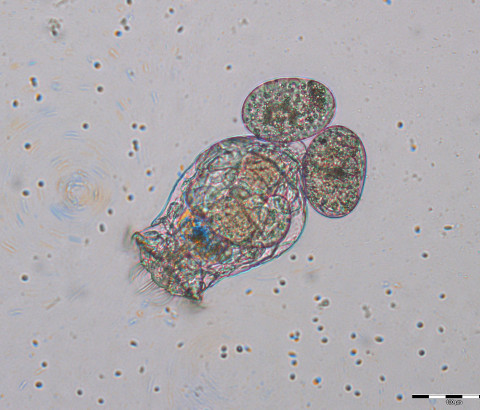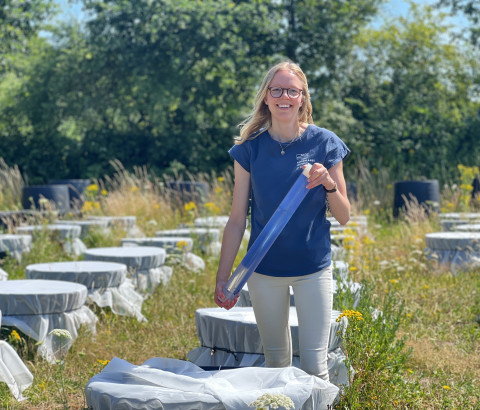Aquatic Ecology

Our mission is to understand aquatic ecosystems, predict their responses to a changing world, and contribute to a sustainable future.
We investigate aquatic interactions and processes in lab, field and model systems over multiple timescales and actively engage with society to protect and improve the health of aquatic ecosystems.
The complementarity of expertise in the Aquatic Ecology department is our strength. By working together, our diverse approaches provide a deeper understanding of ecological processes and interactions.
Faciliteiten
Aquatic ecology and climate change
Climate change is placing unprecedented pressures on our streams, ponds, and lakes. We study how longer-term and extreme climate events such as heatwaves, floods and droughts are changing the ecological balance of water bodies. We engage with stakeholders to explore how nature-based solutions can make our water networks and landscapes more resilient to climate change whilst protecting and enhancing biodiversity.
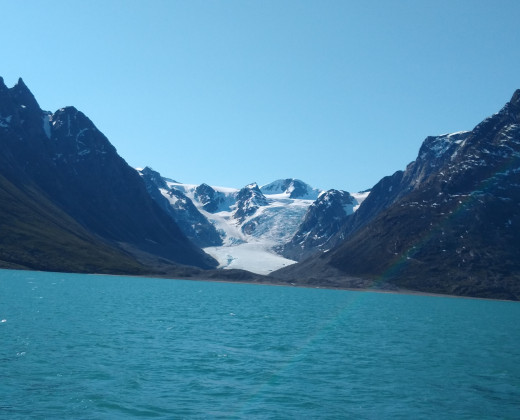
Understanding and restoring aquatic biodiversity
Our fundamental research into rapid evolution of plankton is helping to uncover how species adapt to the changing environment so we can better understand the mechanisms underpinning biodiversity. We also investigate how we as society can adapt by studying sustainable ways to restore and protect water ecosystems through approaches such as rewilding and aim to understand how biodiversity links to ecosystem resilience. To better understand and predict changes in biodiversity, we are developing novel methods for rapid identification of aquatic organisms using DNA analysis to enable more efficient biodiversity monitoring.
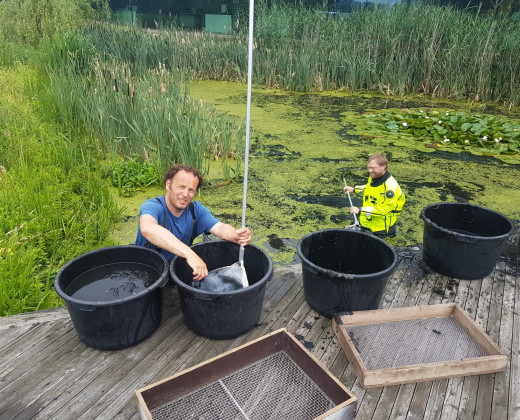
Water quality under pressure
Nitrogen and phosphorus pollution are still among the grand challenges for water management and our ecological approaches help to understand, predict and manage their consequences for water quality, including issues such as cyanobacterial blooms, invasive species and degraded food-webs. We use experimental, modelling and monitoring approaches to understand the drivers of water quality and to determine how societies use and interact with water. We investigate how emergent pollutants such as pharmaceuticals and microplastics are changing the structure and functioning of aquatic systems and conduct research into sustainable water treatment methods.
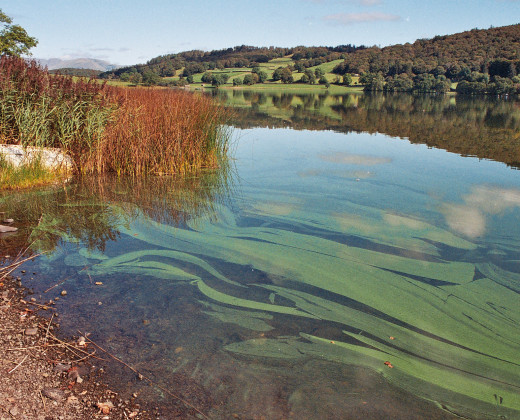
Research support in Aquatic Ecology
Our research assistants have years of experience working in the field and in laboratories, and are experts in aquatic ecology techniques. The team is on hand to support research scientists and students at the NIOO.
Specialist skills within the group include expertise in:
- Flow cytometry and trait identification of phytoplankton
- Water chemistry analysis
- Set-up and operation of experimental mesocosms
- Microscopic identification of zooplankton, phytoplankton and other aquatic invertebrates
- Aquatic plant sampling and identification
- Boat handling and aquatic sampling
- Elemental analysis of waters and sediments
- Chlorophyll and carotenoid pigment analysis
- Operation and maintenance of aquatic sensors
- DNA metabarcoding
- Algal toxin analysis
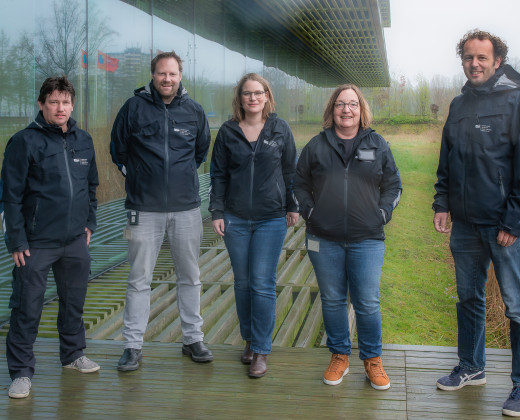
Experiments across scales: our facilities
Our experimental facilities range from outdoor experimental ponds for investigation of entire ecosystems with their full complexity, to microcosms, chemostats and batch experiments in the laboratory for more focused experiments gaining mechanistic understanding on responses of species, communities, and food-webs. The indoor limnotron facility provides a high level of experimental control at a large scale whilst including natural complexity. A sensor network allows access for remote users to track the conditions in each. We regularly deploy outdoor enclosures or exclosures in the field to allow us to conduct experimental manipulations on site.
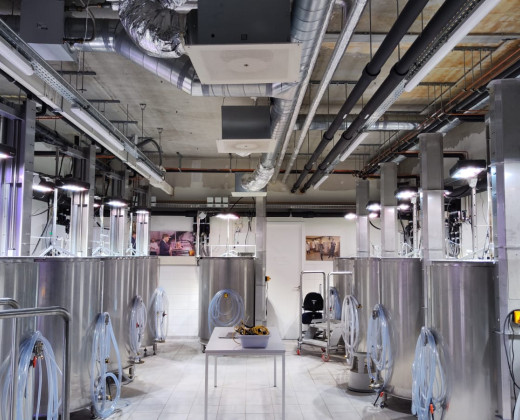
Long-term aquatic ecology
In this period of rapid global change, long-term ecological data are vital for helping us to understand how aquatic ecosystems are responding, and the possible consequences for biodiversity, ecosystem services and resilience. Long-term monitoring programmes at IJsselmeer - the largest lake in the Netherlands - help to understand the linkages between nutrient pollution and algal blooms. Sediment core studies can reveal ecologies of the past, covering decades, centuries and millennia to place recent changes into context. Long-term datasets are vital for supporting and testing the development of aquatic ecosystem models.
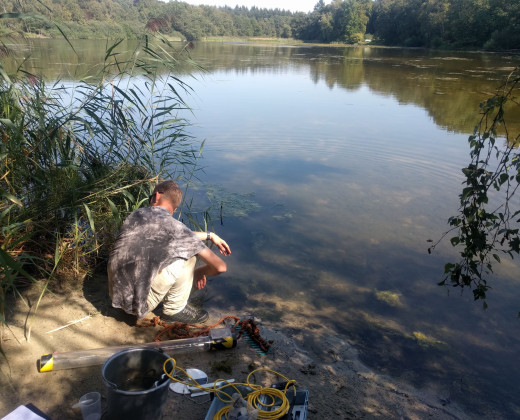
AKWA
Aquatic Knowledge Centre Wageningen (AKWA) is part of the Department of Aquatic Ecology. AKWA translates state-of-the art scientific knowledge into practical solutions for water issues. Stimulated by the growing interest for research valorisation in the Netherlands, AKWA wants to put her valuable scientific knowledge into practice.
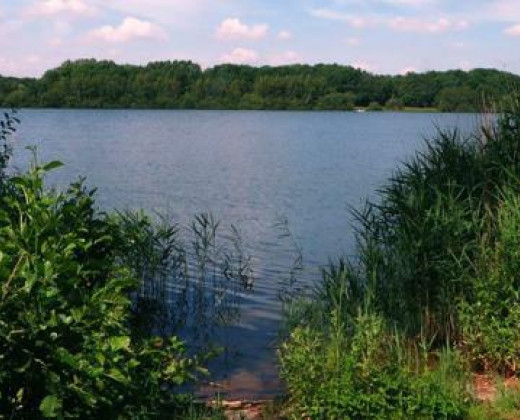
Medewerkers
-
Prof. dr. Suzanne McGowan
- Functie
- Afdelingshoofd

-
Prof. dr. ir. Dedmer Van de Waal
- Functie
- Senior Researcher

-
Em. Prof. dr. Wolf M. Mooij
- Functie
- Researcher
-
Prof. dr. Steven Declerck
- Functie
- Senior Researcher

-
Prof. dr. Lisette de Senerpont Domis
- Functie
- Senior Researcher

-
Dr. Ellen Weerman
- Functie
- Lector

-
Dr. Carel Dieperink
- Functie
- Honorary Fellow

Evenementen
Peer-reviewed publicaties
The effects of a large-scale nature-based solution on the macroinvertebrate diversity in a gravel river in The Netherlands
Non-uniform responses of small fragilarioid taxa to environmental changes in global mountain lakes during the last century
Combined effects of CO2 and nitrogen on the stoichiometry of toxin synthesis in a harmful cyanobacterium
Microbial and Trophic Shifts in the Salt Marsh Palud-Palù, Adriatic Coast
Diatom-inferred water pH variability in response to climate change and acid deposition in subtropical peatlands
Community Assembly of Cladoceran Zooplankton in Relation to Pond Age and the Establishment of Macrophytes and Fish
Best Practices for Optimization of Phytoplankton Analysis in Natural Waters Using CytoSense Flow Cytometers
Wastewater remediation of pharmaceuticals with ozone and granular active carbon
Multi-year water level drawdown and wildlife grazing drive wetland vegetation succession
A versatile model of nutrient retention in relation to ecosystem state in shallow lakes
Modeling the impact of flushing on a lake meta-ecosystem using PCLakeS+
Modeling the impact of surface water abstractions and climate on the ecological quality and recreational potential of a stratified lake
Connecting diversity and process
Intraspecific differences in the effects of salinity and light on growth and prymnesin cell quota in Prymnesium parvum
Carbon sedimentation in shallow floodplain lakes
Multiscale phytoplankton dynamics in a coastal system of the eastern English Channel
Quantifying the contribution of community trait mean and diversity to ecosystem functioning
Advancing water quality model intercomparisons under global change
Sources, Pathways, and Mitigation Strategies for Excess Nitrogen Loading in the Red River Delta, Northern Vietnam
Effects of food quantity and quality on the life history of Daphnia lumholtzi in Mwanza Gulf (Lake Victoria, Tanzania)
Microplastic and microcystin in tropical drinking water reservoir
Women, Water, and the Climate Emergency
Quantitative analyses of stochastic influences on the response to phenotypic selection in a small passerine, the collared flycatcher
Hydrological isolation accelerates algal blooms in floodplain lakes
Length–Dry Mass Relationships of Aquatic Insects
Asymmetric Micro-Evolutionary Responses in a Warming World
Light-Driven Changes in Macrophyte Tissue Quality Affect the Composition of Associated Microbial Communities
Cyclic water level dynamics determine wetland functioning
Temperature Drives Seagrass Recovery Across the Western North Atlantic
Connecting with lakes
Decadal changes in phytoplankton functional composition in the Eastern English Channel
Multiple global change factors and the long‐term dynamics of harmful algal blooms in the North Sea
ParAquaSeq, a Database of Ecologically Annotated rRNA Sequences Covering Zoosporic Parasites Infecting Aquatic Primary Producers in Natural and Industrial Systems
Active wetland restoration kickstarts vegetation establishment, but natural development promotes greater plant diversity
Asymmetrical evolution of cross inhibition in zooplankton
What Does It Mean to Be(Come) Arctic?
Adapting to an increasingly stressful environment
Addressing grand ecological challenges in aquatic ecosystems
Artificial light at night reduces emergence and attracts flying adults of aquatic Diptera
Human activity controls nitrogen loads in a large sub-tropical delta from 2000 to 2020
Continent-Wide Drivers of Spatial Synchrony in Breeding Demographic Structure Across Wild Great Tit Populations
Water level drawdown and perennial vegetation impact litter decomposition in the sediment of a eutrophic wetland in the Netherlands
The promise of community-driven preprints in ecology and evolution
Epiphyton phenology determines the persistence of submerged macrophytes
Abrupt transformation of west Greenland lakes following compound climate extremes associated with atmospheric rivers
Impacts of climate-induced drought on lake and reservoir biodiversity and ecosystem services
The future of algal blooms in lakes globally is in our hands
Riverine connectivity modulates elemental fluxes through a 200- year period of intensive anthropic change in the Magdalena River floodplains, Colombia
Unraveling the Role of Natural Attributes in Driving Lake Ecosystem Response Patterns to Nutrient Variations
Light and temperature as triggers for surface filamentous green algal blooms in shallow freshwater systems
'Smart Nutrient Retention Networks'
Land use, hydroclimate and damming influence organic carbon sedimentation in a flood pulse wetland, Malaysia
Anthropogenic impacts on the water chemistry of a transboundary river system in Southeast Asia
Optimizing nitrogen management for pollution control in Lake Baiyangdian following water replenishment
What’s the matter in phytoplankton?
Zooming in the plastisphere
Defaunation impacts on the carbon balance of tropical forests
Governance Conditions for a Successful Restoration of Riverine Ecosystems, Lessons from the Rhine River Basin
Corrigendum to <Effect of an antidepressant on aquatic ecosystems in the presence of microplastics
Combined measures in lake restoration
Restoring land–water transition areas to stimulate food web development is mediated by the hydrological connectivity
The comparison effect on earthworms between conventional and biodegradable microplastics
Effect of an antidepressant on aquatic ecosystems in the presence of microplastics
Integrated modeling of nature's role in human well-being
The use of living labs to advance agro-ecological theory in the transition towards sustainable land use
Dual impacts of hydrology and damming on eutrophication
Risk assessment of toxic cyanobacterial blooms in recreational waters
Making waves
Communal tapir latrines are foraging sites for tropical forest vertebrates
Unravelling long-term impact of water abstraction and climate change on endorheic lakes
Vegetation dynamics following three decades of trophic rewilding in the mesic grasslands of Oostvaardersplassen
A global map of species at risk of extinction due to natural hazards
Water level drawdown induces a legacy effect on the seed bank and retains sediment chemistry in a eutrophic clay wetland
Float, fly, then sink: wetland plant seed buoyancy is lost after internal dispersal by waterbirds
Changing phenology of benthic primary producers in inland waters
Fragmented marine plastics as the prevalent litter type on a small island beach in the Adriatic
Global trends and scenarios for terrestrial biodiversity and ecosystem services from 1900 to 2050
Transient social–ecological dynamics reveal signals of decoupling in a highly disturbed Anthropocene landscape
Vertebrate grazing can mitigateimpacts of nutrient addition on plant diversity and insect abundance in a semi-natural grassland
Changes in organic carbon properties during intense plankton blooms and macroaggregate formation in the coastal Adriatic Sea, Croatia (case studies in 2020-2022)
EuropaBON EBV workflow templates
Global Lake Health in the Anthropocene: Societal Implications and Treatment Strategies
How nutrient retention and TN:TP ratios depend on ecosystem state in thousands of Chinese lakes
Towards Design Principles for Good Multi-Level Drought Risk Governance: Some Lessons from the Rhine Basin
Sustainable aquatic resource management and inland fisheries in tropical Asia: Interdisciplinary and transdisciplinary approaches
Enhancing the role of International NGOs in promoting the implementation of ecosystem-based adaptation policies
What makes a cyanobacterial bloom disappear? A review of the abiotic and biotic cyanobacterial bloom loss factors
A lake management framework for global application: monitoring, restoring, and protecting lakes through community engagement
Your data FAIR and at work, preparing and storing ecological data for re-use
The interplay between defaunation and phylogenetic diversity affects leaf damage by natural enemies in tropical plants
Hydrostatic pressure impedes the degradation of sinking copepod carcasses and fecal pellets
Impact of mixed microalgal and bacterial species on organic micropollutants removal in photobioreactors under natural light
Hot summers raise public awareness of toxic cyanobacterial blooms
A serious game approach for lake modeling and management: The EscapeBLOOM
Understanding the differential impacts of two antidepressants on locomotion of freshwater snails (Lymnaea stagnalis)
Investigating the role of hydrological connectivity on the processing of organic carbon in tropical aquatic ecosystems
Seed dispersal between aquatic and agricultural habitats by greylag geese
Identifying the controls on nitrate and metabolic state within the Red River delta (Vietnam) with the use of stable isotopes
Nationaal Park Steden
Creating wetland islands to enhance shoreline habitat for fish recruitment in a modified shallow lake
Long-term exposure to experimental light affects the ground-dwelling invertebrate community, independent of light spectra
Process-based modeling for ecosystem service provisioning
Towards climate-robust aquatic ecosystem restoration
Microalgae-based technology for wastewater treatment
Trophic cascades help restore vegetation
Tree cover and its heterogeneity in natural ecosystems is linked to large herbivore biomass globally
The combined effect of pH and dissolved inorganic carbon concentrations on the physiology of plastidic ciliate Mesodinium rubrum and its cryptophyte prey
The hidden impact
Hacking Limnology Workshops and DSOS23
Rapidly evolving zooplankton in a salinizing world
Using lake sediments to assess the long-term impacts of anthropogenic activity in tropical river deltas

